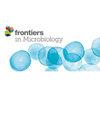中国陕西与套袋苹果黑斑病相关的交替孢属和镰刀菌的鉴定和致病性
IF 4
2区 生物学
Q2 MICROBIOLOGY
引用次数: 0
摘要
苹果是中国陕北地区重要的经济作物。近年来,陕西省延安市苹果主产区在苹果成熟季节出现了一种新型苹果黑斑病--"套袋苹果黑斑病"。它严重影响苹果的外观质量和商业价值。本研究根据形态特征、致病性以及核糖体 DNA 内部转录间隔区(rDNA-ITS)、翻译延伸因子 1-α (EF1-α)、RNA 聚合酶 II 亚基 B(RPB2)、内多聚半乳糖醛酸酶(endo-PG)和匿名区 OPA1-3 的多焦点序列分析,鉴定了从症状苹果中分离的 120 株分离株。其中最多的是交替孢属(64%),其次是尖镰孢属(36%)。通过将这两种真菌单独接种或一起接种到离体苹果(金星和富士品种)上,进行了致病性试验。结果表明,这两种真菌可以单独或同时感染苹果。同时感染会加重病害的严重程度。与交替真菌相比,尖孢镰刀菌导致的病害严重程度和发展速度都有所提高。这是全球首次报道镰刀菌和交替孢菌共同侵染导致苹果黑斑病,也是首次报道尖孢镰刀菌侵染苹果。交替镰刀菌的最适生长温度为 25-30°C,pH 值为 7;尖镰刀菌的最适生长温度为 25°C,pH 值为 7。本文章由计算机程序翻译,如有差异,请以英文原文为准。
Identification and pathogenicity of Alternaria and Fusarium species associated with bagged apple black spot disease in Shaanxi, China
Apple is an economically important fruit crop in northern Shaanxi Province in China. In recent years, a new type of apple black spot disease, “bagged apple black spot disease,” has occurred in the main apple production area of Yan’an City, Shaanxi Province, during the apple ripening season. It seriously affects the appearance quality and commercial value of apples. In this study, 120 isolates recovered from symptomatic apples were identified based on morphological characteristics, pathogenicity, and multilocus sequence analyses of the internal transcribed spacer of ribosomal DNA (rDNA-ITS), translation elongation factor 1-α (EF1-α ), RNA polymerase II subunit B (RPB2 ), endopolygalacturonase (endo-PG ), and anonymous region OPA1-3. Alternaria alternata was the most abundant species (64%), followed by Fusarium acuminatum (36%). Pathogenicity assays were conducted by inoculating them individually and together on detached apples (Venus Golden and Fuji varieties). The results showed that the two fungal species could infect apples individually and together. Co-infection enhanced the disease severity. F. acuminatum led to increased severity and speed of disease development compared to A. alternata . This is the first report of Fusarium and Alternaria co-infection causing apple black spot disease worldwide, and the first report of F. acuminatum affecting apples. The optimal growth of A. alternata occurred at 25–30°C and pH 7; the optimal growth of F. acuminatum occurred at 25°C and pH 7. The results of this study can provide a theoretical basis for exploring the occurrence and epidemiology of apple black spot disease and strategies for its control.
求助全文
通过发布文献求助,成功后即可免费获取论文全文。
去求助
来源期刊

Frontiers in Microbiology
MICROBIOLOGY-
CiteScore
7.70
自引率
9.60%
发文量
4837
审稿时长
14 weeks
期刊介绍:
Frontiers in Microbiology is a leading journal in its field, publishing rigorously peer-reviewed research across the entire spectrum of microbiology. Field Chief Editor Martin G. Klotz at Washington State University is supported by an outstanding Editorial Board of international researchers. This multidisciplinary open-access journal is at the forefront of disseminating and communicating scientific knowledge and impactful discoveries to researchers, academics, clinicians and the public worldwide.
 求助内容:
求助内容: 应助结果提醒方式:
应助结果提醒方式:


